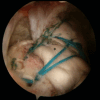Efficacy of latissimus dorsi and teres major tendon transfer in anterosuperior irreparable rotator cuff tears and posterosuperior irreparable rotator cuff tears
- PMID: 39833807
- PMCID: PMC11744838
- DOI: 10.1186/s13018-025-05496-7
Efficacy of latissimus dorsi and teres major tendon transfer in anterosuperior irreparable rotator cuff tears and posterosuperior irreparable rotator cuff tears
Abstract
Background: There are various options of tendon transfer according to the different types of irreparable rotator cuff tears (IRCTs). However, there were no clear treatment options for the IRCTs involving the anterior, superior and posterior rotator cuff tears (global IRCTs). Latissimus dorsi and teres major (LDTM) could be transferred anteriorly or posteriorly in global IRCTs. The purpose of this study is to evaluate the efficacy of LDTM transfer in anterosuperior IRCTs (ASIRCTs) and posterosuperior IRCTs (PSIRCTs).
Methods: The patients who underwent anterior LDTM (aLDTM) transfer (aLDTM group, n = 35) for ASIRCTs or pLDTM transfer (aLDTM group, n = 33) for PSIRCTs between January 2017 and December 2020 were reviewed retrospectively. Clinical and functional outcomes were evaluated based on pain, patient-reported outcome scores, active range of motion (aROM) and strength of aROM. Radiological outcomes were evaluated using arthritic changes in the glenohumeral joint and transferred tendon integrity. Arthritic changes in the glenohumeral joint were evaluated using the acromiohumeral distance (AHD) and Hamada classification on the true anteroposterior radiograph.
Results: No significant intergroup difference was confirmed in patient demographics except for preoperative fat infiltration grade of subscapularis and infraspinatus. The postoperative Constant score, and University of California and Los Angeles (UCLA) score of aLDTM group were significantly higher than that of pLDTM group (p < 0.001 and < 0.001, respectively). Moreover, the achievement of minimal clinically important difference (MCID) for American Shoulder and Elbow Surgeons score and UCLA score showed a significant difference between two groups (p = 0.021 and 0.042, respectively). The postoperative forward elevation (FE) was significantly higher in aLDTM group (p = 0.046). The postoperative FE strength and abduction strength were significantly higher in aLDTM group (p = 0.001 and 0.025, respectively). Moreover, the mean improvement of internal rotation strength in aLDTM group was significantly higher than mean improvement of external rotation strength in pLDTM group (p = 0.011). The progression of arthritic change was significantly higher in pLDTM group (p = 0.002).
Conclusion: Although LDTM transfer is an effective and safe treatment option for ASIRCTs and PSIRCTs, LDTM transfer is more effective for ASIRCTs than PSIRCTs due to its biomechanical advantage and tendon transfer principles.
Level of study: Level III.
Keywords: Irreparable rotator cuff tears; Latissimus dorsi and teres major transfer.
© 2025. The Author(s).
Conflict of interest statement
Declarations. Ethical approval and consent to participate: This study was approved by the Institutional Review Board (ethics committee) of the Ministry of Health and Welfare (IRB No. P01-202411-01-005). The institutional review board permitted this study and exempted the necessity for informed consent because this study was performed retrospectively. Consent for publication: Not applicable. Competing interests: The authors declare no competing interests.
Figures





Similar articles
-
Outcomes of combined anterior latissimus dorsi and teres major tendon transfer for irreparable anterosuperior rotator cuff tears.J Shoulder Elbow Surg. 2022 Nov;31(11):2298-2307. doi: 10.1016/j.jse.2022.03.025. Epub 2022 May 10. J Shoulder Elbow Surg. 2022. PMID: 35550431
-
Joint-preserving treatment for global irreparable rotator cuff tears: combined anterior Latissimus dorsi and Teres major tendon transfer.Arch Orthop Trauma Surg. 2024 Apr;144(4):1473-1483. doi: 10.1007/s00402-023-05196-z. Epub 2024 Jan 29. Arch Orthop Trauma Surg. 2024. PMID: 38285220
-
Combined Anterior Latissimus Dorsi and Teres Major Tendon Transfer (aLDTM) for Irreparable Anterosuperior Rotator Cuff Tears.JBJS Essent Surg Tech. 2024 Apr 19;14(2):e23.00060. doi: 10.2106/JBJS.ST.23.00060. eCollection 2024 Apr-Jun. JBJS Essent Surg Tech. 2024. PMID: 38645756 Free PMC article.
-
Better functional outcomes and a lower infection rate can be expected after superior capsular reconstruction in comparison with latissimus dorsi tendon transfer for massive, irreparable posterosuperior rotator cuff tears: a systematic review.J Shoulder Elbow Surg. 2023 Apr;32(4):892-906. doi: 10.1016/j.jse.2022.11.004. Epub 2022 Dec 14. J Shoulder Elbow Surg. 2023. PMID: 36528222
-
Changes in in vivo three dimensional shoulder kinematics following latissimus dorsi tendon transfer for irreparable posterosuperior rotator cuff tears: A systematic review with meta-analysis.Clin Biomech (Bristol). 2024 Jan;111:106148. doi: 10.1016/j.clinbiomech.2023.106148. Epub 2023 Nov 14. Clin Biomech (Bristol). 2024. PMID: 37979245
References
-
- Bedi A, Bishop J, Keener J, Lansdown DA, Levy O, MacDonald P, et al. Rotator cuff tears. Nat Rev Dis Primers. 2024;10(1):8. - PubMed
MeSH terms
LinkOut - more resources
Full Text Sources
Medical
Research Materials

